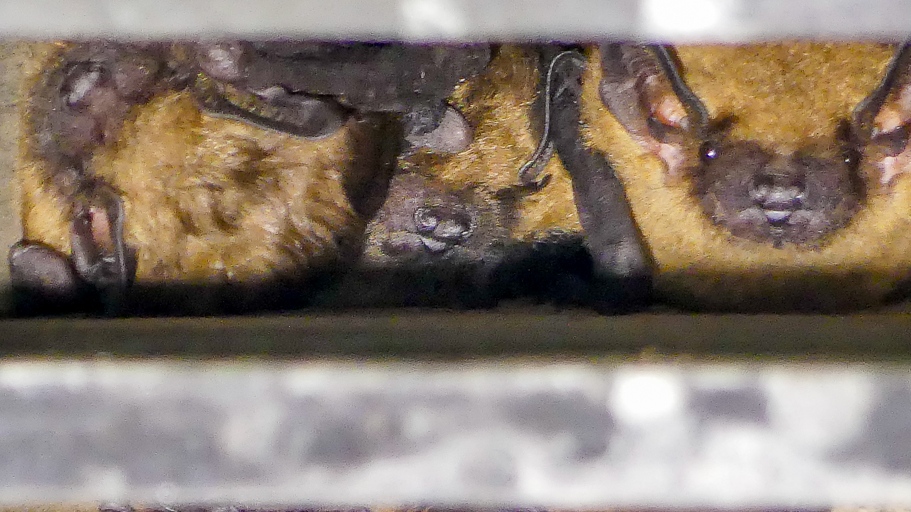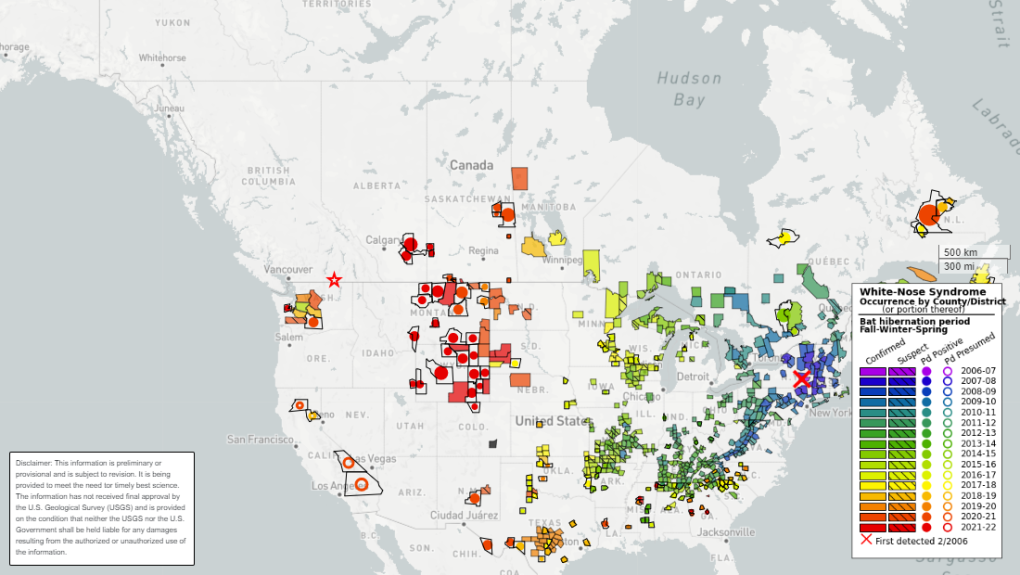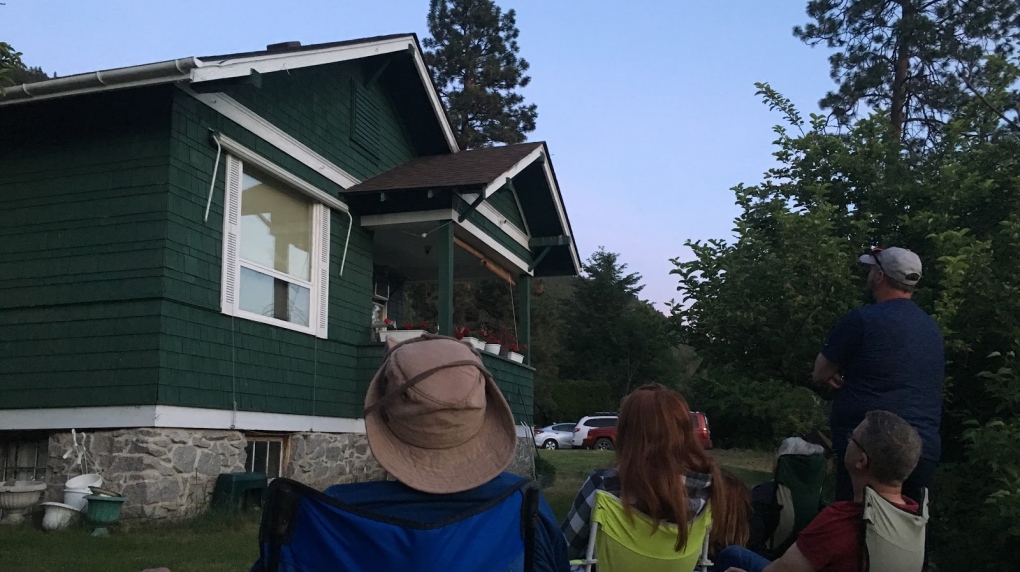Scientists seek volunteers to help protect B.C. bats against deadly disease
 Bats peek out of a roosting site. (J. Saremba, Burke Mountain Naturalists)
Bats peek out of a roosting site. (J. Saremba, Burke Mountain Naturalists)
A bat signal has gone up in search of people who want to help track the nocturnal flying mammals in B.C., in the name of science and conservation.
The BC Community Bat Program is looking for volunteers to count bats at local roost sites around the capital region starting in June.
The B.C. Annual Bat Count helps biologists understand bat distribution and monitor for impacts of a devastating bat disease called white-nose syndrome.
The fungal disease has been slowly making its way across Canada and is fatal for bats, but does not seem to affect other animals or people.
"We are monitoring roosts that we know of for white-nose syndrome," said Danielle Buckle, wildlife stewardship coordinator for Habitat Acquisition Trust.
"By testing the guano, we have not found it on Vancouver Island yet. But, unfortunately, this year it was found in British Columbia," she said.
Bats are an essential part of the ecosystem, consuming many insect pests each night.
A common species of bat found in buildings and bat boxes is the Little Brown Myotis. Unfortunately, it is endangered in Canada due to white-nose syndrome.
 White-nose syndrome spread map with BC detection shown with a red star. (BC Community Bat Program)Results from the Bat Count data may help prioritize areas in B.C. for research into treatment options and recovery actions for bats threatened by the deadly fungus, like the Little Brown Myotis.
White-nose syndrome spread map with BC detection shown with a red star. (BC Community Bat Program)Results from the Bat Count data may help prioritize areas in B.C. for research into treatment options and recovery actions for bats threatened by the deadly fungus, like the Little Brown Myotis.
"It’s really important to know how our bat populations are doing year after year," said Buckle. "So having volunteers come out and help us makes that process a little bit easier."
According to the BC Annual Bat Count, the evening monitoring is easy, fun, and safe, not to mention vital for monitoring bat populations.
"The counts are a wonderful way for people to get outside, learn about bats, and be involved in collecting important scientific information," said Mandy Kellner, provincial coordinator for the BC Community Bat Program.
Volunteers wait outside a known roost site, such as a bat-box, barn, or attic, and count bats as they fly out at twilight. A guano sample can also be sent in to identify the species of bat at the roost site.
 Volunteers gather at dusk to help monitor bats. (Okanagan Community Bat Project)The BC Community Bat Program is funded by the Habitat Conservation Trust Foundation, the Forest Enhancement Society of BC, the Habitat Stewardship Program, and receives support from the BC Conservation Foundation and the B.C. government
Volunteers gather at dusk to help monitor bats. (Okanagan Community Bat Project)The BC Community Bat Program is funded by the Habitat Conservation Trust Foundation, the Forest Enhancement Society of BC, the Habitat Stewardship Program, and receives support from the BC Conservation Foundation and the B.C. government
Starting in June, there will be four bat counts this summer, tracking both pre- and post-birth populations.
More information on how to volunteer can be found on the B.C. Bats website.
CTVNews.ca Top Stories

Donald Trump says Canada becoming 51st U.S. state is 'a great idea.' Jean Charest calls the comment a 'wake-up call'
U.S. President-elect Donald Trump is taking aim at Canada once more, saying it would be 'a great idea' to make it America's ‘51st state.'
'You're either with Beijing or you're with Washington': Ford says to Mexico in CNN interview
Ontario Premier Doug Ford has a message for Mexico as the threat of tariffs by incoming president Donald Trump hangs over both sides of the U.S. border.
There are 88 new Order of Canada appointees. Here's a look at some of the most notable names
Ryan Reynolds, Scott Oake and Maureen Ann Jennings are among the 88 new recipients of the Order of Canada.
NEW Here's how the cost of living challenges are shaking up Canadian seniors' retirement plans
With the high cost of living increasingly a concern, some seniors are making sacrifices to help their adult children and grandchildren make ends meet. Here are some of their stories.
Thousands of toddler step stools recalled after child's head gets stuck
Thousands of toddler step stools are being recalled after a child's head got stuck in one.
Iconic Halifax ship Theodore Too partially sunk at Ontario dock
An iconic ship that was a fixture in Halifax Harbour for 21 years has partially sunk in Ontario.
Brazilian judge orders Adele song removed over plagiarism claim
A judge in Rio de Janeiro has ordered the global removal of a 2015 song by British singer Adele due to a plagiarism claim by a Brazilian musician, which Universal Music is fighting on appeal.
After scamming their victims, some con artists go on to scam our courts with impunity
Convicts, including fraudsters, are skipping out on their court-ordered payments to their victims to the tune of tens of millions of dollars across the country, according to figures obtained by CTV W5.
Synagogue on Montreal's West Island targeted by alleged arson
A synagogue on Montreal's West Island was the target of an alleged arson attack.


































